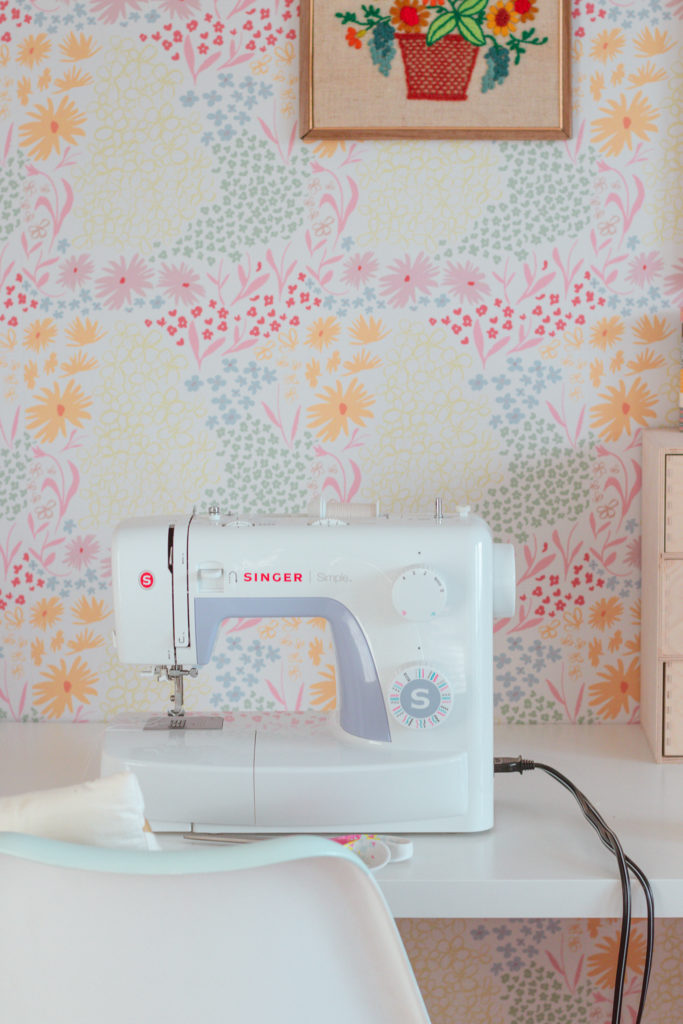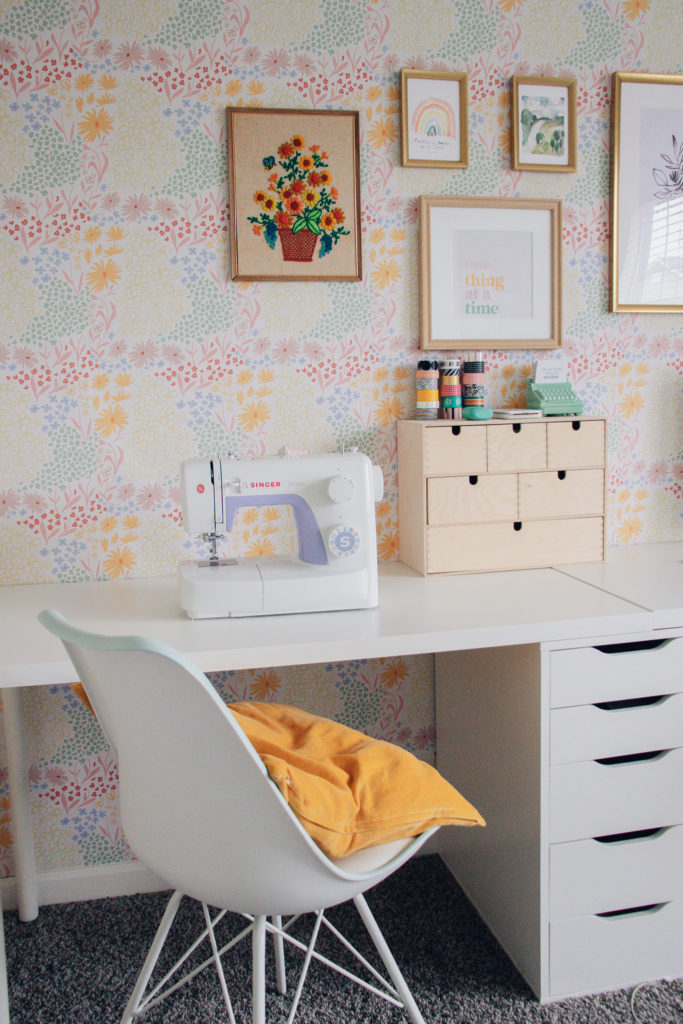
I had never used a sewing machine until December 26th, 2018. The day before (Christmas day) I unwrapped my cute little Singer sewing machine…the one I’d asked for…because I had been hit by the sewing bug HARD.
One of my favorite Instagram accounts to follow was sharing her sewing projects, which took me down a rabbit hole of the incredible, inspirational, super-fashionable garment sewing community on Instagram. I was HOOKED.
Since I’ve shared my beginner sewist adventures online, I’ve heard from a lot of people in my community that have always wanted to try garment sewing, but are intimidated. And also from people that enjoy sewing household items, quilting, making a few alterations here or there, but are scared to make the leap into sewing clothing because it feels so different and so advanced. I feel you!
I created this blog post to help you feel confident about the idea of sewing clothing…whether you’re starting there (like I did) or moving into clothing…I promise, it’s not nearly as scary as it seems!
First, I want to bust some myths I had heard about garment sewing before I ever began.
Myth: You shouldn’t start with clothing.
Truth: I started with clothing and I have zero regrets.
‘Starting’ with clothing doesn’t mean the first line you ever stitch should be a hem on a dress. Absolutely not! I bought a bunch of squares of quilting cotton and practiced sewing lines, curves, and piecing fabrics together. I think I spent two hours doing this on the first night I got my machine. It was a wonderful confidence builder, an excellent way to learn how to thread my machine correctly, troubleshoot a few basic problems that popped up, and generally enjoy my first experience.
If you want your first project to be clothing, I highly recommend taking an online class like ‘Sewing Isn’t Scary’ by Elise Joy or any of the classes that Tilly and The Buttons have available. You need to have a basic understanding of the terminology that comes along with garment sewing, and the general rules that go along with it. Either of these resources will help you leaps and bounds in your sewing adventure.
I also watched pretty much every video on this Youtube Channel and would use these projects as confidence builders when garment sewing was frustrating. Because, it will be in the beginning.

Myth: Sewing Clothing is more affordable than purchasing clothing
Truth: Not really. Fast Fashion makes it *too* affordable to shop in large quantities, and shop often. Sewing clothing can be expensive, because buying fabric is expensive. Especially buying denim, specialty fabric, or designing your own fabric and purchasing from a Print on Demand site like Spoonflower.
Myth: Sewing your own clothing is a quick fix!
Truth: Sewing (and sewing right) is a slow process. But ‘slow’ is relative. I only have a few hours of sewing in me before I start to lose patience. Most pieces take me at least 3-4 hours to complete (some, more like 5-7), which will be completed over the course of a few days. I also have a lot of UFOs (Unfinished Objects) hanging in my closet that have been waiting to be finished for an embarrassing amount of time. Sometimes, you just lose interest in a project, and who knows when you’ll be ready to dive back in. No biggie, just be prepared that this might happen.
Myth: Sewing clothing is a whole other world from other types of sewing (curtains, pillows, basic quilts, etc) Aka: it would be hard to master both
Truth: Yes, but mostly no. It’s all about stitching lines. It’s all about piecing things together in the correct order. It’s all about measurements. If I had to say what was technically easier, I would say a pillow case is easier than a tank top. But when you’re following a good pattern, sewing a tank top is really quite easy, and very rewarding. I have sewn through about 12-ish different patterns since I started sewing (I’ve really taken it quite slow), and I’ve yet to encounter one that I thought was truly *hard.*
Truth: Quilting is truly a whole other animal, and I find it very technically challenging. But not impossible! My little machine just can’t quilt. More on that in a minute…
Now that we have some myths busted, let’s talk about sewing basics:
The Machine
I chose my machine after a couple hours of research and a few recommendations from people on Instagram. (Namely, Elise Joy had shared what she started with and that was good enough for me). I chose a Singer Simple based on 4 things: good reviews, low cost, marketed for the beginner, and how darn cute it is. I wouldn’t lie to you all—aesthetics always factor into a purchase. That’s just who I am.
Looking back, I don’t regret choosing this machine. It is pretty fabulous for most clothing fabrics. It *doesn’t* handle heavier fabrics like denim or upholstery fabrics very well at all. I have yet to sew any jeans or overalls for this reason. Additionally, I don’t think my little Singer Simple would be ideal for quilting, because quilting involves a lot of layers of fabric. So far, this hasn’t been an issue for me, since I’m not yet ready or really excited to try pants and I’m not super into quilting (yet!).
Bottom Line: Decide what’s important to you in a machine, and go for it. I have really enjoyed using a Singer, but have heard great things about Brother machines. Lots of machines have tons of bells and whistles, which I think would be awesome now that I’ve been sewing for 1.5 years. As a beginner, bells and whistles would have added to the intimidation I felt about learning to use the machine.
Other items you will need to start:
-A couple spools of thread
-A seam ripper
-Fabric Scissors
-A rotary cutter (a MUST for cutting fabric from your patterns)
-A cutting mat (or a hard floor or table you can cut on)
-Some fabric to start practicing with
-Pin cushion
-Pins
-Tape measure
-Sewing Machine

Finding a great beginner pattern:
I find traditional paper patterns really hard to read. I don’t know why! This is just a ‘me’ thing. However, I love ‘indie’ patterns because you can print the patterns from your home printer and the instructions are very detailed and easy to read and understand. ‘Indie’ patterns are patterns created by independent pattern makers, like all the ones I’m about to list:
These are the patterns I recommend for a beginner:
Ogden Cami (link: https://shop.truebias.com/product/ogden-cami) (I have made 3-4 camis, including a dress version where you simply lengthen the hem)
Wiksten Shift (Top Version) (link: https://shopwiksten.com/products/womens-modern-shift-dress-top-sewing-pattern): although the dress is really easy too, you can make the top with or without pockets. Pockets are actually very simple, they just require double and triple-checking that everything is lined up properly)
The Ashton Top (link: https://helensclosetpatterns.com/product/ashton-top-pdf-pattern/) I haven’t made this one, but it looks adorable and super simple)
The Collins Top (link: https://shop.inthefolds.com/products/collins-top-pattern?variant=13803969871974) I have made this one and I love it. I suggest making it in a rayon fabric so it will not be so ‘structural.’ It involves sewing with a button, so it feels a little more advanced. This is a great top though, and a super rewarding make!
You might notice all these beginner patterns are simple tops and tank tops. That’s because these are the easiest to make! And also, the most fun. I don’t have a real desire to sew pants or skirts and that is fine. Just because you want to sew clothing, doesn’t mean you have to make every single thing under the sun. You may really love dresses. Or JUST skirts. Or just leggings! I don’t know, it’s your sewing adventure and you get to decide what happens.
If you’d like to explore all my favorite Indie Brands, here are the ones I’ve purchased from:
Wiksten
True Bias
In The Folds
Tilly and the Buttons
Seamwork
Megan Nielsen
Closet Case Patterns
How long should you expect until you’re ‘good’ at sewing clothing?
Realistically, anywhere from 6 months to a year. If you sew a LOT, it could be 6 months or less. This, I think, will be different for everyone.
There is more that goes into sewing good clothing than just being able to sew well. It’s about the fabric choice, the pattern choice, and choosing things you will *actually* want to wear. I am now sewing things that I will continually reach for after about 18 months of sewing. However, I would say I was definitely sewing wearable garments at 7-8 months. It just wasn’t always ‘my style’ in the end. If you think about how many things you purchase from the store that you end up never wearing, it is really the same with sewing. It will take some experimentation to know what works for you.
Where do you get your fabrics?
So far, I have purchased the bulk of my fabric from my local Jo-Ann. As it happens, Lexington (where I live) has one of very few Super Jo-Ann stores in the country, with an extensive fabric inventory. It. is. Amazing! However, I’ve purchased from fabric.com and Cottoneer and have had a good experience with both.
I can also recommend Blackbird Fabrics
And Stonemountain and Daughter Fabrics as being reputable, and amazing.
Is it worth it?
It’s a lot of time, it’s not the cheapest hobby, and it takes a lot of practice. But YES, it is so, so worth it. Sewing is an incredibly rewarding hobby. It is fulfilling in ways I didn’t expect it to be. It’s a useful, needed skill. If you are feeling the itch to start sewing, I can’t tell you how happy it has made me and how thankful I am to have learned this skill. I hope this post has given you the confidence to jump in!